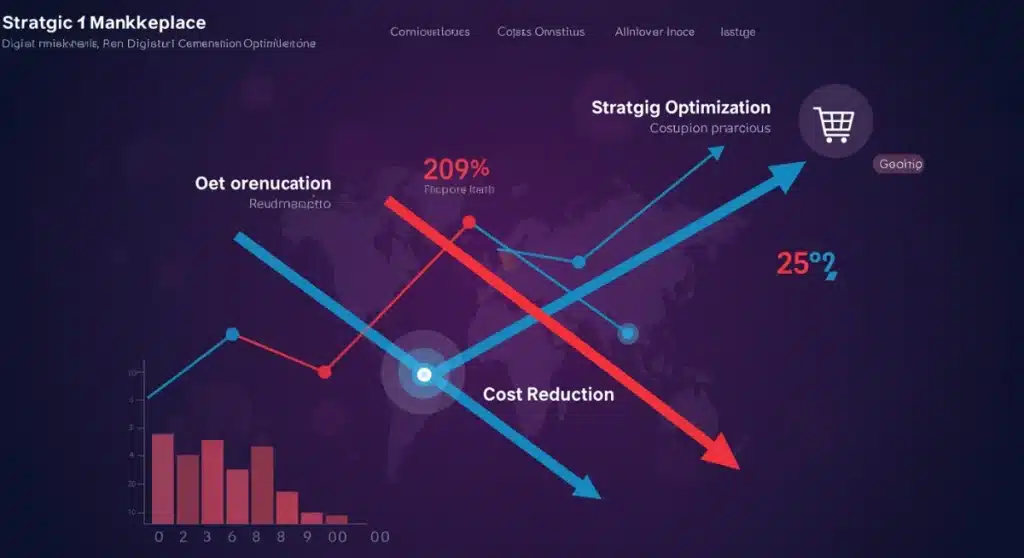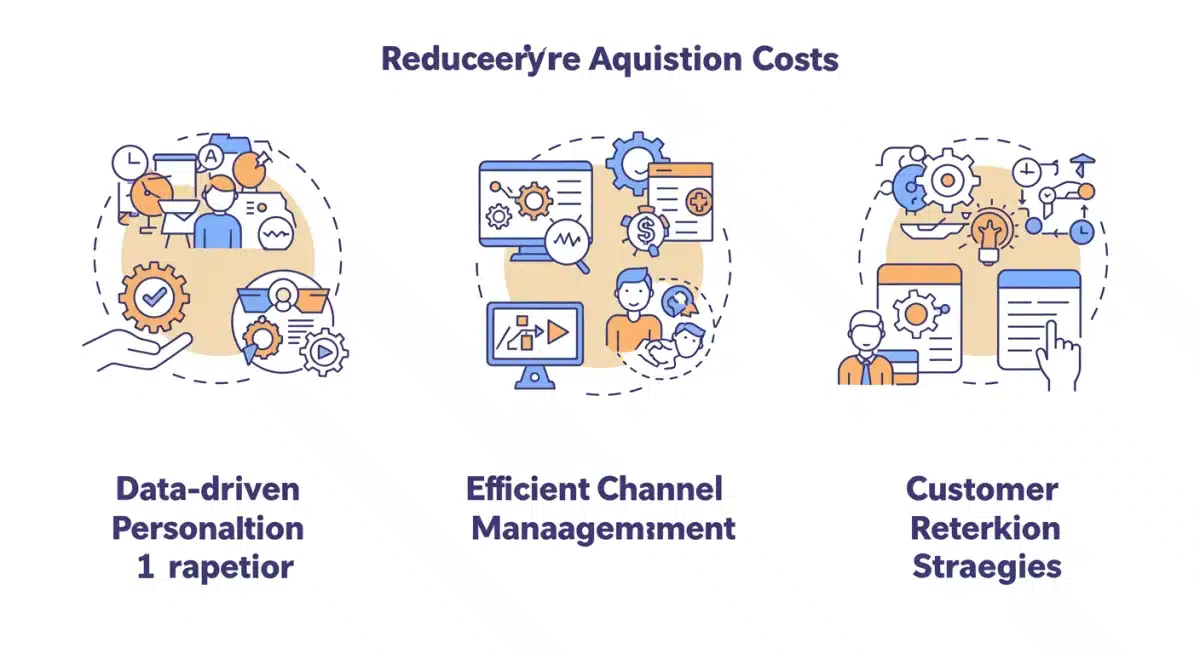Optimize Your Online Store for 2025: Reduce Acquisition Costs by 20%

Optimizing Your Online Store for 2025: A 3-Step Guide to Reducing Acquisition Costs by 20% (FINANCIAL IMPACT) is now paramount for e-commerce survival and growth, demanding immediate strategic shifts to achieve significant financial savings and improved profitability.
The digital retail landscape is evolving at an unprecedented pace, making the need for strategic adjustments more critical than ever. For online businesses looking to thrive, Optimizing Your Online Store for 2025: A 3-Step Guide to Reducing Acquisition Costs by 20% (FINANCIAL IMPACT) is not just a recommendation, but a vital roadmap. This guide offers actionable insights to help merchants significantly curtail spending on customer acquisition while boosting overall profitability.
Understanding the Urgency: Why 2025 Demands Cost Reduction
As of late 2024, market trends indicate a notable increase in customer acquisition costs (CAC) across various e-commerce sectors. This upward trajectory, influenced by heightened competition and evolving advertising algorithms, necessitates a proactive approach from online retailers. Businesses failing to adapt risk diminished profit margins and stunted growth in the upcoming year.
The shift towards a more discerning consumer base, coupled with data privacy regulations, further complicates traditional marketing efforts. Retailers must move beyond broad-stroke campaigns and embrace more targeted, efficient strategies. A 20% reduction in CAC, as targeted for 2025, translates directly into substantial financial impact, freeing up capital for product development, enhanced customer experience, or market expansion.
The Rising Cost Landscape
Recent reports from leading digital marketing analytics firms highlight a consistent year-over-year increase in paid advertising costs. This trend is expected to continue into 2025, making efficient resource allocation a top priority. Understanding these escalating costs is the first step toward effective mitigation.
- Increased competition in key advertising channels.
- Smarter algorithms demanding higher quality ad content.
- Consumer fatigue with generic marketing messages.
- Impact of new data privacy regulations on targeting capabilities.
Step 1: Data-Driven Personalization and Audience Segmentation
The cornerstone of reducing acquisition costs lies in understanding your audience deeply and tailoring experiences to their specific needs. Generic marketing campaigns are increasingly ineffective, leading to wasted ad spend and low conversion rates. By leveraging data analytics, online stores can identify high-value customer segments and personalize their outreach.
This involves collecting and analyzing customer data, including browsing behavior, purchase history, demographic information, and engagement patterns. Tools ranging from CRM systems to AI-powered analytics platforms are crucial for this endeavor. The goal is to deliver the right message to the right person at the right time, drastically improving the efficiency of marketing efforts.
Implementing Advanced Analytics
Effective data-driven personalization requires more than just basic analytics. It demands advanced tools that can process large datasets and identify nuanced patterns. Businesses should invest in platforms that offer predictive analytics and customer journey mapping capabilities.
- Utilize AI-powered recommendation engines for product suggestions.
- Segment email lists based on purchase history and engagement.
- Create dynamic website content tailored to individual visitor profiles.
- Employ A/B testing for personalized landing pages and ad creatives.
Step 2: Optimizing Marketing Channels for Efficiency
Not all marketing channels are created equal, especially when aiming for cost reduction. A critical step for 2025 involves a thorough audit of current marketing channels to identify those delivering the highest return on investment (ROI) and those that are underperforming. This strategic reallocation of resources is vital for achieving the 20% CAC reduction target.
Focus should be placed on channels that allow for precise targeting and offer robust analytics to track performance. This might mean scaling back on broad social media campaigns in favor of highly specific search engine marketing (SEM) or influencer partnerships that resonate deeply with niche audiences. The objective is to maximize impact per dollar spent.

Evaluating Channel Performance
A systematic review of each marketing channel’s performance is necessary. This involves analyzing metrics such as conversion rates, cost per click (CPC), cost per acquisition (CPA), and overall ROI. The insights gained will inform strategic decisions on where to invest and where to divest.
For instance, while social media can offer broad reach, its direct conversion efficiency might be lower for certain products compared to targeted Google Ads. Understanding these nuances allows for a more efficient allocation of marketing budget, ensuring every dollar works harder. Furthermore, exploring emerging, less saturated channels can offer lower initial acquisition costs.
Step 3: Enhancing Customer Retention and Lifetime Value
While often overlooked in acquisition strategies, improving customer retention directly impacts CAC. A loyal customer base generates repeat purchases, reducing the need for constant new customer acquisition. Focusing on increasing customer lifetime value (CLTV) can contribute significantly to a 20% reduction in overall acquisition costs by 2025.
This involves implementing robust post-purchase strategies, such as loyalty programs, exceptional customer service, and personalized follow-up communications. Creating a seamless and positive customer journey from initial interaction to repeat purchase fosters loyalty and turns customers into brand advocates, generating organic growth and reducing reliance on paid channels.
Building Lasting Customer Relationships
Customer retention is not merely about preventing churn; it’s about cultivating a relationship that encourages sustained engagement and advocacy. This requires a holistic approach that extends beyond the initial sale, focusing on continuous value delivery and attentive service.
- Implement a tiered loyalty program with exclusive benefits.
- Provide proactive customer support and personalized assistance.
- Send targeted email campaigns based on previous purchases and preferences.
- Encourage user-generated content and reviews to build community.
Leveraging AI and Automation for Predictive Insights
The integration of Artificial Intelligence (AI) and automation tools is no longer a luxury but a necessity for optimizing online store operations and reducing CAC. AI can analyze vast amounts of data to predict customer behavior, identify churn risks, and automate personalized marketing messages. This significantly enhances efficiency and accuracy in targeting efforts.
Automated marketing flows, powered by AI, can trigger specific actions based on customer interactions, such as sending abandonment cart reminders or personalized product recommendations. This not only saves time and resources but also ensures timely and relevant communication, improving conversion rates and fostering customer loyalty. The ability of AI to adapt and learn from new data makes it an indispensable tool for staying ahead in a dynamic market.
Automating Customer Journeys
Automated customer journeys streamline interactions and ensure no potential lead or existing customer is overlooked. From initial contact to post-purchase follow-up, automation ensures consistent and timely engagement, which is crucial for both acquisition and retention.
For example, AI-driven chatbots can handle routine customer inquiries, freeing up human agents for more complex issues. Marketing automation platforms can segment customers and deliver tailored content at scale, leading to higher engagement and conversion rates. This level of operational efficiency directly contributes to a lower CAC.
The Role of User Experience (UX) in Cost Reduction
A seamless and intuitive user experience (UX) on your online store plays a critical, yet often underestimated, role in reducing customer acquisition costs. A poorly designed website with confusing navigation or slow loading times can lead to high bounce rates and abandoned carts, meaning that any investment in driving traffic to the site is effectively wasted. Conversely, an optimized UX ensures that visitors stay longer, engage more deeply, and are more likely to convert.
Investing in UX optimization means ensuring your website is mobile-responsive, loads quickly, has clear calls to action, and offers an easy checkout process. These improvements directly enhance conversion rates, making each paid click or organic visit more valuable. By improving the efficiency of your website in converting visitors, you inherently reduce the cost associated with acquiring each paying customer.
Optimizing the Conversion Funnel
Every step of the customer journey, from landing page to checkout, must be optimized for minimal friction. This involves continuous testing and refinement based on user behavior data. A smooth conversion funnel ensures that the traffic you acquire is more likely to turn into sales.
- Ensure fast website loading speeds across all devices.
- Simplify navigation and product discovery.
- Streamline the checkout process with minimal steps.
- Provide clear and compelling product descriptions and high-quality images.
Future-Proofing Your Online Store: Beyond 2025
While the immediate focus is on 2025, successful online stores adopt strategies that provide long-term resilience and growth. The principles of data-driven decision-making, efficient resource allocation, and customer-centricity are not transient but foundational for sustained success in e-commerce. Future-proofing involves continuously monitoring market trends, embracing technological advancements, and maintaining agility in strategy.
This includes exploring new platforms, understanding emerging consumer behaviors, and anticipating regulatory changes. By building a flexible and adaptable operational framework, online businesses can navigate future challenges and capitalize on new opportunities, ensuring that the financial impact of reduced acquisition costs extends well beyond the immediate target year.
Continuous Adaptation and Innovation
The digital market is constantly evolving, demanding continuous adaptation. Businesses must foster a culture of innovation, regularly reviewing and updating their strategies to stay competitive.
This includes investing in ongoing employee training, exploring new marketing technologies, and maintaining a robust feedback loop with customers to inform future decisions. Proactive engagement with market shifts ensures that your online store remains relevant and profitable for years to come.
| Key Point | Brief Description |
|---|---|
| Data-Driven Personalization | Tailoring marketing efforts and website experiences based on deep customer data analysis to improve conversion efficiency. |
| Optimizing Marketing Channels | Rethinking and reallocating marketing budget to high-ROI channels, reducing spend on underperforming platforms. |
| Enhancing Customer Retention | Investing in loyalty programs and superior customer service to increase CLTV and reduce the need for constant new acquisition. |
| Leveraging AI & UX | Utilizing AI for predictive insights and ensuring a seamless user experience to boost conversion rates and operational efficiency. |
Frequently Asked Questions About E-commerce Optimization
Reducing CAC is crucial for 2025 due to escalating competition and rising advertising expenses in the e-commerce sector. Lowering these costs by 20% directly improves profit margins, frees up capital for other investments, and ensures sustainable growth in a challenging market environment.
Data-driven personalization reduces CAC by allowing online stores to target specific customer segments with highly relevant messages. This precision increases conversion rates and minimizes wasted ad spend on generic campaigns, making marketing efforts significantly more efficient and cost-effective.
Optimizing marketing channels involves conducting a thorough audit of current channels to identify those with the highest ROI. Businesses should reallocate resources from underperforming channels to those providing better returns, focusing on precise targeting and robust performance analytics to maximize impact per dollar spent.
Customer retention significantly lowers acquisition costs by fostering a loyal customer base that generates repeat purchases. This reduces the need to constantly acquire new customers, as existing ones contribute to revenue through increased lifetime value and often become brand advocates, driving organic growth.
AI and UX are vital for optimization. AI provides predictive insights for personalized marketing and automation, enhancing efficiency. A superior user experience (UX) on the website improves conversion rates, reducing bounce rates and abandoned carts, making every acquired visitor more likely to convert into a paying customer.
What This Means
The directives for Optimizing Your Online Store for 2025: A 3-Step Guide to Reducing Acquisition Costs by 20% (FINANCIAL IMPACT) underscore a critical shift in e-commerce strategy. Businesses that embrace these proactive measures are poised to gain a significant competitive edge. The emphasis on data, efficiency, and customer loyalty signals a maturation of the digital retail space, where sustainable growth is increasingly tied to smart, cost-effective operations rather than sheer volume of ad spend. This is not merely about surviving but about thriving in an evolving market.